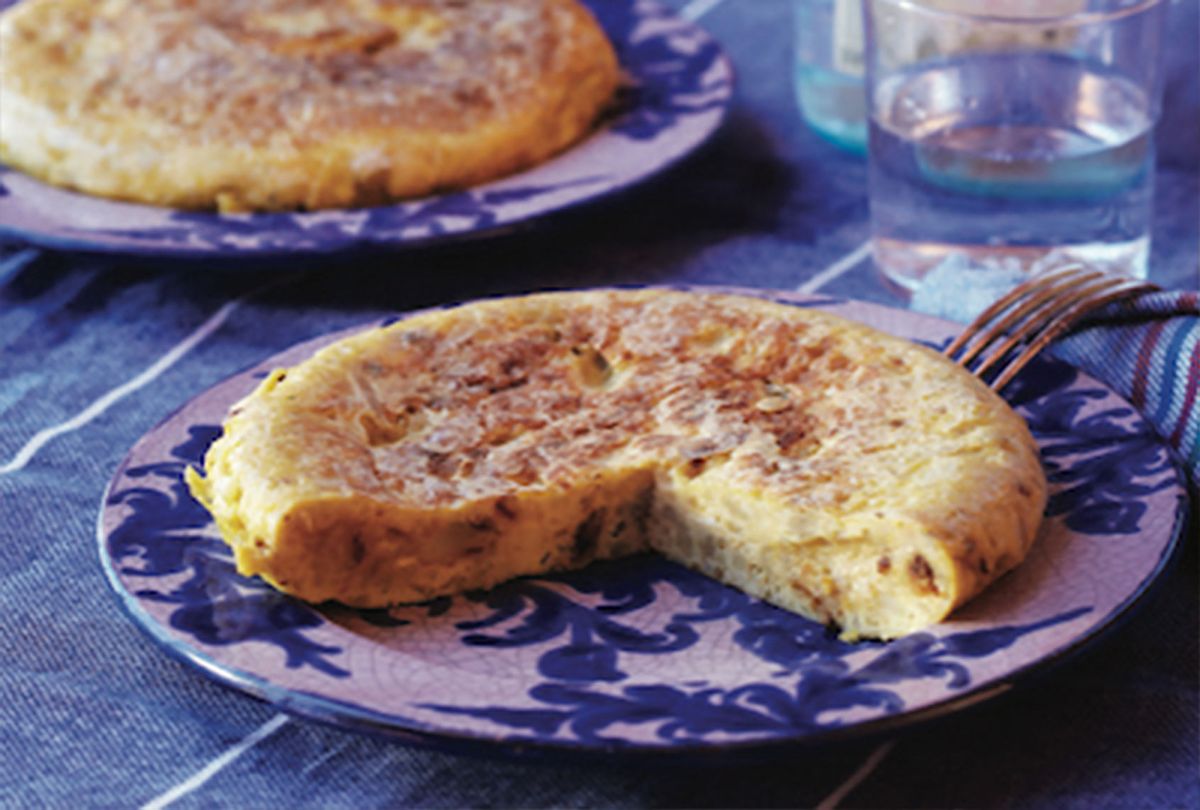The former chef at Boqueria and Tertulia in New York City explores the most emblematic Spanish dish — rich with history and more like an omelette than a taco — and the story of when he learned to cook it in Spain.
I first fell in love with the tortilla española when I was in high school. For the uninitiated, this is nothing like a taco, though I confess to being confused, too. I was 16-years-old, having freshly arrived in Burgos in north-central Spain to kick off a year abroad exchange program. My retention of the Spanish language was dismal, and my knowledge of Spanish culture was very limited. I think everything I knew about Spain I learned from reading the children's book "Ferdinand the Bull."
Here I was, day one in a foreign country, in a bar with my host father, sipping a glass of rose wine (yes, the first thing he did was take a 16-year-old American kid to a bar to drink wine!), waiting for the tortilla he ordered, expecting some spicy Mexican taco to arrive. Instead, the waiter returned with a wedge of room-temperature, eggy, potato-heavy pie. I was confused. I assumed that I had misunderstood what we ordered, but the one word I had distinctly been able to pick out in the machine-gun fire of Castilian vocabulary, was "tortilla." Yet here we were, about to eat a cold omelet.
I grew up on a farm in Vermont, cooking and eating delicious food from a very young age. By now, I was already a foodie (long before that divisive word existed). I tucked into that tortilla, and my life as a food lover was forever changed. With four ingredients: eggs, potato, salt, and most importantly, extra virgin olive oil, it was so simple, yet sublime. We ordered a second. And then, of course, a third. Little did I know that the tortilla española is the subject of national debate in Spain, the cause of epic arguments, the obelisk of culture. It is the cornerstone of a national culinary identity. I had to learn how to make it.
Like so many "simple" things in the kitchen, making a good tortilla takes years to perfect and requires a level of detail and attention that are lost on the uninitiated. A true master of the tortilla observes and coaxes the magic out of the humblest of pies. My first attempts were abysmal. The notorious vuelta, or flip, is where the problems usually start. When the pie is at the halfway point, the pan is covered with a plate or a lid, and the whole shebang is flipped in a single motion and then slipped back into the pan to cook on the other side.
I watched my host mother do this effortlessly, like Anna Pavlova performing a grande jeté. My first attempts were more reminiscent of Jackson Pollock paintings all over the floor, cupboard and ceiling. With practice, I mastered the vuelta, only to learn that it's just the beginning of the journey. What I love so much about this dish is how the subtlest of changes can completely alter the final product. And while all Spaniards can agree that it is the most iconic dish, everyone has their own opinion on what constitutes a "traditional" tortilla. With onion? Heresy to some, fundamental to others. The one thing that is for certain: The fewer ingredients, the closer to its purest form. In truth, there are as many recipes for tortilla española in Spain as there are grandmothers. And to every Spaniard, their grandma's is the one true recipe.
Here is what I have learned over the past 31 years making this dish:
- Excellent-quality extra virgin olive oil from Spain is fundamental.
- Peel and thinly slice waxy potatoes and then gently cook them, fully submerged in the olive oil at a low temperature until creamy, and begin to break apart, losing the sliced form.
- Strain the potatoes and reserve the oil for next time. Season the potatoes in a bowl with a little salt.
- Crack and gently whisk 8 eggs into large Pyrex glassware to measure (this can be done by eye once you've mastered the next step).
- Add equal volume of cooked potato to the eggs (e.g. for 3 cups of eggs, add 3 cups of potato mixture).
- Heat up 2 tablespoons of the reserved olive oil in a large non-stick pan (or very well-seasoned cast-iron) over medium-high heat. Gently roll the oil around the pan.
- Add egg-potato mixture and gently fold edges away from the perimeter of the pan using a heat-resistant rubber spatula.
- Leave it to set for a few minutes.
- When the egg has just set, but the top is still very wet and uncooked, cover with a large plate and flip.
- As quickly as possible, wipe the pan clean and add another tablespoon of oil, then carefully slip the half-cooked tortilla back into the pan. It will be ugly, fear not.
- Carefully tuck the edges of the tortilla under to create a nice rounded exterior.
- Once the egg sets, shake the pan gently to release it. The eggs should have a little golden-brown color.
- Using a cake tester or a tiny knife, puncture the tortilla a few times to release hot air trapped inside so it doesn't puff up.
- Grab a clean plate and flip again. Touching the center to check for doneness. It should still be a little wet and runny inside.
- Slip onto a serving plate and let cool. It should be served at room temperature.
- The final product should be an inch or so in thickness, perfectly rounded around the edge, evenly browned, with eggs that are not too hard, and an inside that's creamy but not too runny. The defining taste should be in the following order: egg, potato, and most importantly, olive oil.
- Lastly, to truly understand the magic of the tortilla, it is best enjoyed in the evening, with a beer or a glass of wine.
The beauty of mastering this dish is that it becomes an important page in every cook's repertoire. Even after mastering the dish, it's still so easy to screw up. It requires a level of attention and observation that forces us to forget our predilection to multi-tasking and brings us into a moment of solemn craft as cooks. Being equipped to whip up a tortilla at a moment's notice with ingredients you always have in the kitchen is a great trick to have up your sleeve.
Here's a version from my first cookbook, "Hero Food," that I love to make. Practice, practice and you will find beauty in the simplicity of this dish.
***
Recipe: Tortilla Española
Ingredients:
- 8 eggs, lightly beaten
- 4 Yukon gold potatoes, peeled and thinly sliced
- 2 cups olive oil
- Sea salt, as needed
Directions:
- Submerge the sliced potatoes in olive oil and cook on low heat for 35 minutes until the potatoes are completely cooked and begin to fall apart.
- Strain and reserve the olive oil. Transfer the potatoes to a mixing bowl and season with sea salt.
- Combine equal parts egg and potato.
- Heat 2 tablespoons of the reserved oil in a medium-sized non-stick pan over medium-high heat. Add the egg mixture and fold the edges away from the pan with a heat-resistant rubber spatula.
- Cook until the edges are just set, about 5-7 minutes, then cover with a large plate and carefully flip. Wipe out the pan with a paper towel, return to the heat with 1 tablespoon of the reserved olive oil.
- Add the tortilla back into the pan and continue to cook the other side, folding the edges to create a nice rounded perimeter. Flip as many more times as needed to create an attractive, rounded edge.
- Remove to a plate and set aside to cool. Serve with a glass of wine or beer.
By Institute of Culinary Education Chef Seamus Mullen




Shares